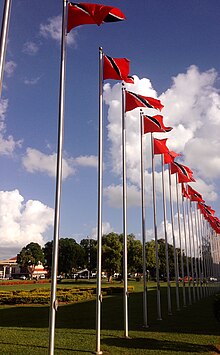 | |
| Flag of the Republic of Trinidad and Tobago The Sun-Sea-Sand Banner | |
| Use | National flag |
|---|---|
| Proportion | 3:5 |
| Adopted | 31 August 1962 |
| Design | A red field with a white-fimbriated black diagonal band from the upper hoist-side to the lower fly-side. |
| Designed by | Carlisle Chang |
| Civil ensign of the Republic of Trinidad and Tobago | |
 | |
| Use | Civil and state ensign |
| Proportion | 1:2 |
| Design | A red field with a white-edged black diagonal band from the upper hoist-side to the lower fly-side. |
| Naval ensign of the Republic of Trinidad and Tobago | |
 | |
| Use | Naval ensign |
| Proportion | 1:2 |
| Design | A White Ensign with the National Flag in the canton |
The flag of Trinidad and Tobago was adopted upon independence from the United Kingdom on 31 August 1962. Designed by Carlisle Chang (1921–2001), the flag of Trinidad and Tobago was chosen by the independence committee of 1962. Red, black and white symbolise fire (the sun, representing courage), earth (representing dedication) and water (representing purity and equality).
It is one of the few national flags incorporating a diagonal line, with other examples including the DR Congo, Tanzania, Namibia, and Brunei.
Design

The flag of Trinidad and Tobago is a red field with a white-edged black diagonal band from the upper hoist side to the lower fly-side. In blazon, Gules, a bend Sable fimbriated Argent. It was designed by Carlisle Chang.
Construction

The width of the white stripes is 1⁄30 of the flag length and the width of the black stripe is 2⁄15. The total width of the three stripes together is, therefore, 1⁄5 of the length.
Other flags
The civil ensign is the national flag in a 1:2 ratio. The naval ensign (used by Coast Guard vessels) is a British white ensign with the national flag in the canton.
-
Presidential Standard
-
Prime Minister's Standard
-
 Queen Elizabeth II's personal Trinidadian flag (1966–1976)
Queen Elizabeth II's personal Trinidadian flag (1966–1976)
British colonial flag
Prior to independence from the United Kingdom in August 1962, Trinidad and Tobago used a British blue ensign defaced with a badge depicting a ship arriving in front of a mountain.
See also
- Flag of the West Indies Federation (January 1958 – May 1962)
- Coat of arms of Trinidad and Tobago
References
- ^ "Carlisle Chang" Archived 2016-09-11 at the Wayback Machine, Ministry of Community Development, Culture and the Arts, Government of the Republic of Trinidad and Tobago.
- ^ "National flag of Trinidad and Tobago - Carlisle Chang", YouTube.
- ^ Carlisle Chang biography Archived 2015-07-11 at the Wayback Machine, NALIS.
- ^ National Flag Archived 2021-10-22 at the Wayback Machine". Government of the Republic of Trinidad and Tobago. Retrieved May 12, 2017.
- ^ Chang, Carlisle (1998). "Chinese in Trinidad Carnival". The Drama Review. 43 (3): 213–19. doi:10.1162/105420498760308571. JSTOR 1146692. S2CID 57571669.
- ^ Flagspot







